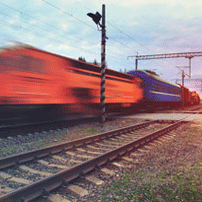Amtrak’s “Failing” Safety Culture
February 22, 2018 In April 2016, Amtrak passenger train 89 collided with a backhoe (a type of excavation equipment) in Chester, Pennsylvania. Although the operator tried to stop after he observed the equipment and employees working on the track, he was unable to do so before the train made impact.
In April 2016, Amtrak passenger train 89 collided with a backhoe (a type of excavation equipment) in Chester, Pennsylvania. Although the operator tried to stop after he observed the equipment and employees working on the track, he was unable to do so before the train made impact.
In the months following the derailment, toxicology reports confirmed that the three Amtrak employees involved in the incident had all tested positive for various narcotics – the train operator for marijuana, the backhoe operator for cocaine and the supervisor on duty for opioids.
The National Transportation Safety Board (NTSB) determined that the accident resulted because of Amtrak’s failure to have a “clear, consistent and accepted vision for safety.” In its official statement the NTSB examines not only how the train derailment occurred but also warns that if Amtrak does not make changes, another accident is bound to happen.
Even though traveling by train is usually safe, approximately 1,000 die in train-related accidents annually – and thousands more are injured.
According to the NTSB’s findings, some of the main causes behind the 2016 derailment were:
- Allowing a train to travel at maximum authorized speeds on an unprotected train track with workers present;
- A lack of shunting devices, and:
- Amtrak’s inconsistent safety management and safety views
Shunting devices can be used to indicate when and where work is being performed on a railroad track. Safety measures like shunting devices are often referred to as a kind of “redundant signal protection”; they’re in place for the primary purpose of communicating hazards to reduce accident risks. Although its investigation didn’t determine that drugs were the primary factor in the accident, the NTSB did note that their presence indicated Amtrak’s “weak safety culture”.
This isn’t anywhere near the first time that a deadly Amtrak crash has occurred. In 2015, 8 individuals were killed and more than 200 were injured in a derailment in the Port Richmond area of Philadelphia. And just weeks ago, over 100 people were injured and 2 crewmembers were killed in a head-on collision with a parked freight train in South Carolina. Yet again, the lack of a comprehensive and effective safety culture at Amtrak is being labeled as the probable cause behind the accident.
People employed in “safety-sensitive” positions should be held to high standards. Safety-sensitive positions are jobs where the employee is responsible for both his or her own safety as well as the safety of others, such as a train operator or railroad worker. Even though drugs weren’t the reason behind the Chester train derailment, they have been in other fatal Amtrak accidents. Amtrak needs to have an effective drug-testing program in place to ensure that its employees are capable of being responsible for the safety of not only themselves, but also others.
Railroad companies are supposed to do everything they can to limit harm to passengers but it seems like Amtrak could be doing much, much more. When a company like Amtrak fails to abide by federal and/or state safety standards and people are hurt or killed as a result, it may be found liable for an array of legal damages. Determining liability is often a lengthy and complex process, which is why it can be so helpful to talk with a lawyer about how to proceed.
If Amtrak doesn’t prioritize the health and safety of its passengers and employees, deadly accidents like these will continue to happen. As such, the NTSB is recommending that Amtrak make several changes, such as ensuring that the labor unit is in compliance with safety programs, conducting risk assessments on engineering products to determine whether or not they should occur and others. If you or a loved one were injured in a train accident and have questions, please contact a representative at our firm directly.
Philadelphia Train Accident Lawyers at Galfand Berger, LLP Represent Individuals Injured in Train Accidents
If you or a loved one was injured in a train accident, please contact the Philadelphia train accident lawyers at Galfand Berger. With offices located in Philadelphia, Bethlehem, Lancaster, and Reading, we serve clients throughout Pennsylvania and New Jersey. To schedule a consultation, call us at 800-222-8792 or complete our online contact form.
 Google Screened
Google Screened
